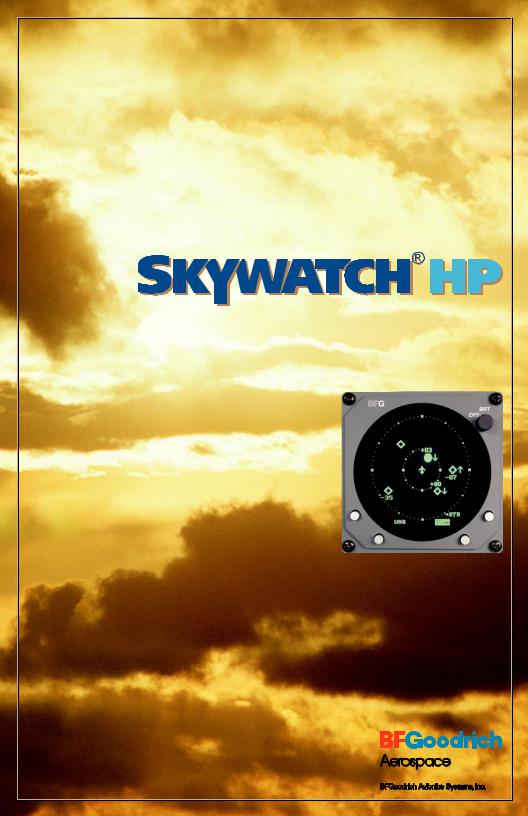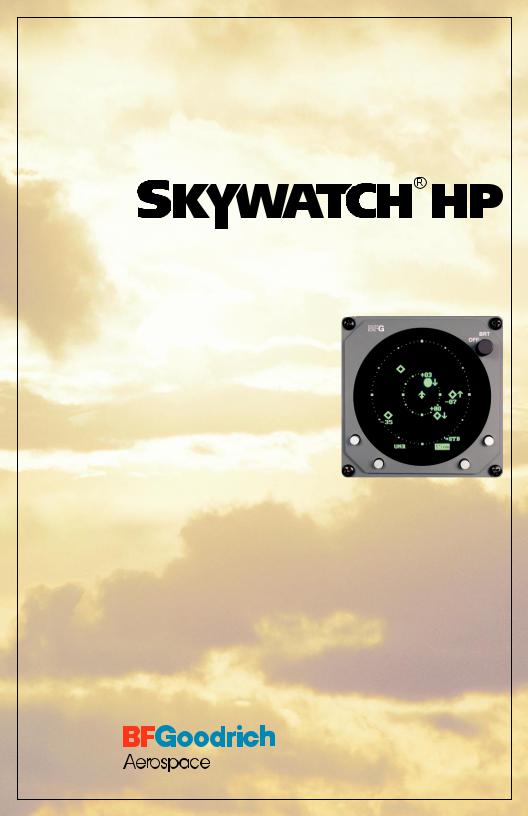BFGoodrich SKY899 User Manual

$12.00 U.S.
PreliminaryPilot’s Guide
for the
Traffic Alert/Advisory System
Model SKY899

Eyes That Never Blink™
Early Traffic Alert/Advisory Systems
In the early days of flight, pilots were equipped with all they needed for effective collision avoidance–a sharp pair of eyes.
PreliminaryBut increasing traffic at higher speeds led to the development of TCAS I and II (Traffic Alert and Collision Avoidance Systems)
which were too expensive for most regional airlines, business aircraft, and general aviation aircraft.
SKYWATCH®
BFGoodrich Avionics Systems, Inc. recognized the need for an alternative to expensive TCAS systems and developed the SKYWATCH model SKY497 Traffic Advisory System (TAS) and the SKYWATCH HP model SKY899 TAS/TCAS I.
The SKYWATCH HP can be installed as a TAS to provide most of the capabilities of TCAS I, but at a significantly lower cost, making it practical for small aircraft. The SKYWATCH HP can also be installed as a TCAS I.
In addition to its TCAS I capability, SKYWATCH HP improves upon the SKY497 by adding ADS-B surveillance, a larger display range (15 nmi), and a higher maximum closure rate (1200 kn).
Proven Experience
BFGoodrich Avionics Systems, Inc. has been involved in the development of collision warning programs since the early 1980’s. In 1985, BFG began development of an enhanced collision warning system for the Navy’s T-34C training aircraft.
Based largely on the success of the Navy project, BFG was selected to validate the specifications for TCAS I. As a result, BFG’s original TCAS I unit, the TCAS791 was the first TCAS I to be TSO’d, first to receive a full, unrestricted STC, first to fly, and first to be delivered.
A |
SKY899 Pilot’s Guide |

$12.00 U.S.
Pilot’s Guide
for the
Traffic Alert/Advisory System
Model SKY899
Methods and apparatus disclosed and described herein have been developed solely on company funds of BFGoodrich Avionics Systems, Inc. No government or other contractual support or relationship whatsoever has existed which in any way affects or mitigates proprietary rights of BFGoodrich Avionics Systems, Inc. in these developments. Methods and apparatus disclosed herein may be subject to U.S. Patents existing or applied for. BFGoodrich Avionics Systems, Inc. reserves the right to add, improve, modify, or withdraw functions, design modifications, or products at any time without notice.
|
© Copyright 2001 |
|
BFGoodrich Avionics Systems, Inc. |
® |
® |
Preliminary™ |
|
SKYWATCH |
, EYES THAT NEVER BLINK , and STORMSCOPE are trademarks of |
BFGoodrich Avionics Systems, Inc.
Designed and manufactured in the United States of America by
BFGoodrich Avionics Systems, Inc. 5353 52nd Street, S.E.
Grand Rapids, MI 49512 USA
(800) 253-9525 or (616) 949-6600 Fax (616) 285-4224 www.bfgavionics.com

Safety Summary
CAUTION |
To avoid power surges that could damage the SKY899 and the |
|
page 3-1 |
optional WX-1000, start your engines before turning on the SKY899. |
|
|
||
|
If the SKY899 is in SKYWATCH mode, the display will not auto- |
|
page 3-5 |
matically switch into Stormscope mode to display thunderstorms or |
|
|
Stormscope errors. Use the remote SKYWATCH/Stormscope mode |
|
|
switch to periodically check for thunderstorms or Stormscope errors. |
|
|
The SKY899 relies on information obtained from transponders in |
|
page 3-6 |
nearby aircraft. The SKY899 does not detect or track aircraft which |
|
|
are not equipped with an operating Air Traffic Control Radar |
|
|
Beacon System (ATCRBS) transponder. |
|
|
The SKY899 does not track intruder aircraft approaching at a |
|
page 3-6 |
closure rate greater than 1200 knots. |
|
|
Some traffic within the chosen display range may not be displayed |
|
page 3-6 |
due to traffic prioritizing, antenna shielding, or ground intruder |
|
|
filtering. |
|
CAUTION |
Optimum SKY899 performance is realized when intruder aircraft |
|
are reporting their altitude (via a mode C or other altitude |
||
page 3-6 |
||
reporting transponder). |
||
|
||
|
Do not attempt evasive maneuvers based solely on traffic informa- |
|
page 3-6 |
tion on the display. Information on the display is provided to the |
|
Preliminary |
||
flight crew as an aid in visually acquiring traffic; it is not a replacement for Air Traffic Control (ATC) and See & Avoid techniques.
ii |
SKY899 Pilot’s Guide |

Table of Contents
Section |
Page |
|
List of Illustrations ....................................... |
|
v |
List of Tables............................................... |
|
vi |
Abbreviations & Acronyms............................ |
|
vii |
PreliminaryTurn Off the SKY899 and the Optional WX-1000 ....................... |
3-7 |
|
Chapter 1, System Description ................... |
1-1 |
|
General Description ................................................................... |
|
1-1 |
Transmitter Receiver Computer (TRC) ........................................ |
|
1-2 |
Directional Antenna ................................................................... |
|
1-2 |
Display ...................................................................................... |
|
1-3 |
Interaction of Major Components ............................................... |
|
1-4 |
Functional Description ............................................................... |
|
1-4 |
Features ..................................................................................... |
|
1-6 |
Chapter 2, Controls & Indicators ................. |
2-1 |
|
Introduction .............................................................................. |
|
2-1 |
Controls, Indicators, & Symbols ................................................. |
|
2-1 |
Controls Required for the Stormscope Option ............................... |
|
2-5 |
Controls & Indicators for an Alternate Display ............................. |
|
2-6 |
Aural Announcements ................................................................ |
|
2-6 |
Chapter 3, Operating Instructions ............... |
3-1 |
|
Introduction .............................................................................. |
|
3-1 |
Turn On the SKY899 ................................................................. |
|
3-1 |
Run the Operator-Initiated Self Test ............................................ |
|
3-3 |
Switch Between Standby & Normal Operating Mode ................... |
|
3-3 |
Change the Display Range .......................................................... |
|
3-4 |
Change the Vertical Display Mode ............................................... |
|
3-5 |
Switch Between SKYWATCH & Stormscope .................................. |
|
3-5 |
Observe the Display ................................................................... |
|
3-6 |
Respond to Traffic Advisories ...................................................... |
|
3-6 |
Operate the WX-1000 Without the SKY899 ............................... |
|
3-7 |
Operate the SKY899 Without the WX-1000 ............................... |
|
3-7 |
Message Response ...................................................................... |
|
3-7 |
Respond to a Failed System .................................................... |
|
3-7 |
Respond to a Degraded System .............................................. |
|
3-9 |
SKY899 Pilot’s Guide |
iii |

Table of Contents (continued)
Section |
Page |
Chapter 4, Principles of Operation ............... |
4-1 |
Introduction .............................................................................. |
4-1 |
Sensitivity Levels ........................................................................ |
4-1 |
Sensitivity Level A ................................................................. |
4-1 |
Sensitivity Level B ................................................................. |
4-3 |
Preliminary |
|
Audio Inhibit, SKY899 ............................................................... |
4-5 |
Audio Inhibit, GPWS, EGPWS, or TAWS ................................... |
4-5 |
TA Symbol Duration .................................................................. |
4-6 |
Ground Intruder Filtering ........................................................... |
4-6 |
ADS-B ...................................................................................... |
4-6 |
Chapter 5, Display Interpretation ................ |
5-1 |
Introduction .............................................................................. |
5-1 |
Chapter 6, Specifications ........................... |
6-1 |
Chapter 7, Warranty Information ................ |
7-1 |
Introduction .............................................................................. |
7-1 |
Warranty Statement .................................................................... |
7-1 |
Related Policies and Procedures ................................................... |
7-2 |
iv |
SKY899 Pilot’s Guide |

List of Illustrations
Figure |
Title |
Page |
|
1-1 SKY899 Major Components .............................................................. |
|
1-1 |
|
1-2 Display with Typical SKYWATCH HP Screen .................................... |
|
1-3 |
|
1-3 Display with Typical Stormscope Screen (Optional) ............................. |
|
1-3 |
|
1-4 System Block Diagram ....................................................................... |
|
1-5 |
|
Preliminary |
1-7 |
||
1-5 Vertical Display Modes and Traffic Zones ............................................ |
|
||
2-1 Controls & Screen Elements in Standby .............................................. |
|
2-1 |
|
2-2 Controls & Screen Elements in Operating Mode ................................. |
|
2-2 |
|
2-3 Vertical Display Mode Indicator Lamps ............................................... |
|
2-6 |
|
3-1 |
BFGoodrich Screen ........................................................................... |
|
3-1 |
3-2 |
Standby Screen .................................................................................. |
|
3-2 |
3-3 |
In-Flight Traffic Screen....................................................................... |
|
3-2 |
3-4 |
Failed Screen ..................................................................................... |
|
3-2 |
3-5 |
Test Screen ........................................................................................ |
|
3-3 |
3-6 Traffic Screen on the Ground .............................................................. |
|
3-4 |
|
3-7 |
Display Ranges .................................................................................. |
|
3-4 |
3-8 Message Screen with Two Messages ..................................................... |
|
3-9 |
|
3-9 Message Screen with No Messages .................................................... |
3-10 |
||
4-1 TA Zones If Your Aircraft Has a Radio Altimeter .................................. |
|
4-4 |
|
4-2 TA Zones If Your Aircraft Has No Radio Altimeter, But Does Have a |
|
|
|
|
Retractable Landing Gear ................................................................... |
|
4-4 |
4-3 TA Zones If Your Aircraft Has No Radio Altimeter |
|
|
|
|
and a Fixed Landing Gear ................................................................... |
|
4-5 |
4-4 |
ADS-B ............................................................................................. |
|
4-6 |
5-1 TA & OT on 15 nmi Range, UNR Mode ........................................... |
|
5-1 |
|
5-2 Other Traffic on 15 nmi Range, UNR Mode ....................................... |
|
5-2 |
|
5-3 Other Traffic on 6 nmi Range, NRM Mode ......................................... |
|
5-2 |
|
5-4 TA & OT on 2 nmi Range, BLW Mode .............................................. |
|
5-2 |
|
5-5 Off-Screen TA on 2 nmi Range, ABV Mode ........................................ |
|
5-3 |
|
5-6 |
Standby Screen .................................................................................. |
|
5-3 |
5-7 |
Failed Screen ..................................................................................... |
|
5-3 |
SKY899 Pilot’s Guide |
v |

List of Tables
Table |
Title |
Page |
|
4-1 Fourteen Situations in Which a Traffic Advisory Will Occur |
................. 4-2 |
||
6-1 |
|
TRC899 Specifications ...................................................................... |
6-1 |
6-2 |
BFG WX-1000/SKY497 Display Specifications .................................. |
6-3 |
|
6-3 |
|
NY164 Directional Antenna Specifications |
|
Preliminary |
|||
|
|
(for TAS installations only) ................................................................. |
6-4 |
6-4 |
|
NY156 Directional Antenna Specifications |
|
|
|
(required for TCAS I installations, optional for TAS) ............................... |
6-4 |
vi |
SKY899 Pilot’s Guide |

Abbreviations & Acronyms
ABV |
Above |
Ack |
Acknowledge |
ADS-B |
Automatic Dependent Surveillance-Broadcast |
AFM |
Aircraft Flight Manual |
PreliminaryI/O Input/Output |
|
AFS |
Flight Standards Service |
AGL |
Above Ground Level |
AHRS |
Attitude and Heading Reference System |
Alt |
Altitude |
ARINC |
Aeronautical Radio, Inc. |
ATC |
Air Traffic Control |
ATCRBS |
Air Traffic Control Radar Beacon System |
ATI |
Air Transport Indicator |
ATM |
Air Traffic Management |
BFG |
BFGoodrich |
BFGAS |
BFGoodrich Avionics Systems, Inc. |
BLW |
Below |
Comm |
Communication |
CPA |
Closest Point of Approach |
CRT |
Cathode Ray Tube |
EFIS |
Electronic Flight Instrument System |
EGPWS |
Enhanced Ground Proximity Warning System |
FAA |
Federal Aviation Administration |
fpm |
Feet Per Minute |
FSAW |
Flight Standards Information Bulletin for |
|
Airworthiness |
GPS |
Global Positioning System |
GPWS |
Ground Proximity Warning System |
Grnd |
Ground |
HP |
High Performance |
IVSI |
Instantaneous Vertical Speed Indicator |
kn |
Knots |
MFD |
Multi-Function Display |
Mod |
Modification |
SKY899 Pilot’s Guide |
vii |
